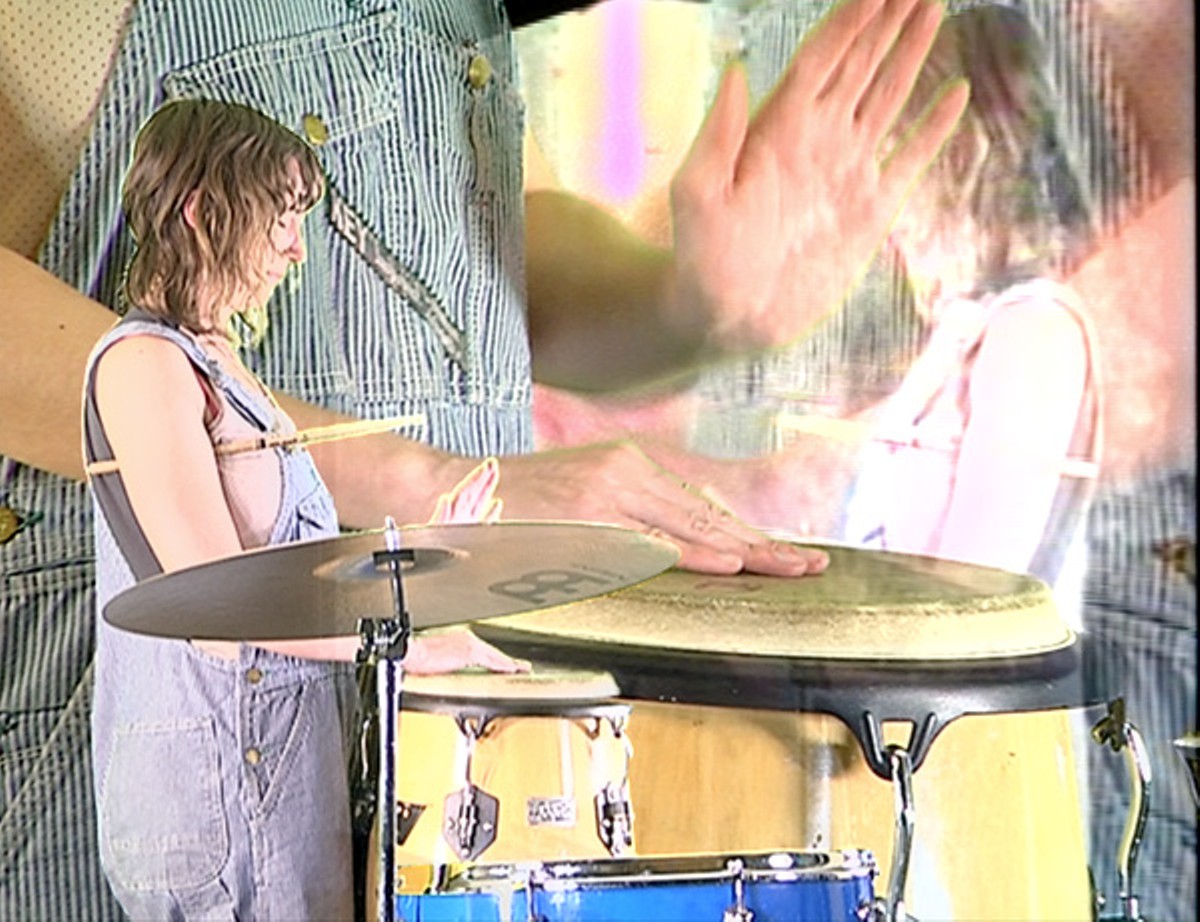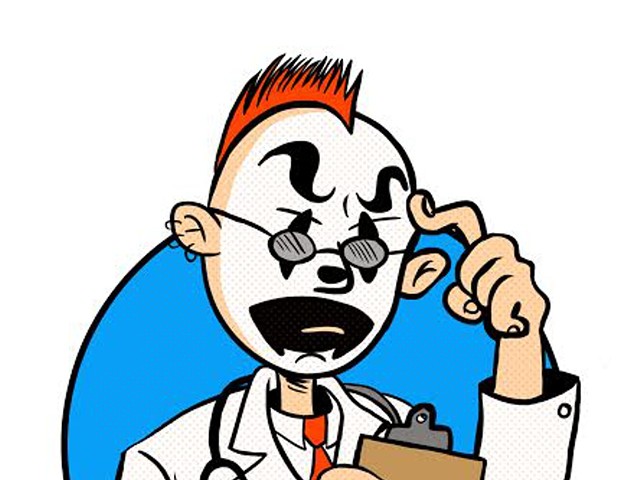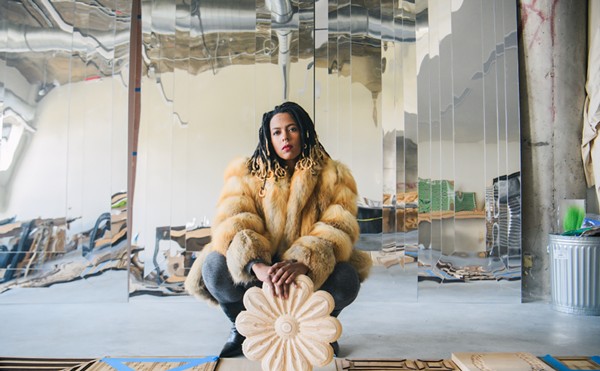It's not super easy to explain what an ESP event is like, or what their work in general is, so please bear with me. The clearest single explanation they themselves provided to the Internet reads "ESP TV is a project dedicated to promoting the performing and media based arts through direct collaboration with artists via live television production." And that's not even very clear. You can check out lightly edited versions of their past events at esptv.com.
The heart of what Scott Kiernan and Victoria Keddie do is — using an old-school news van with a satellite dish up top and racks of gear inside — they travel to various places and produce their own live variety-type show. They're using the language of television, of old-school variety shows. The roughly two-hour event is recorded live. Various old-school video synthesizer-type effects will be superimposed at times, and you can watch those on monitors spread throughout the event.
Keddie and Kiernan are great curators, and they're also artists themselves. Wherever the ESP crew goes, they interact with and feature local artists. Detroit's performance will feature video works already created by area artists, plus live performances by musicians and performance artists. At least one artist will be providing little commercial breaks throughout the night, which will be hosted by professional voice actor Ted Shumaker. We spoke with Victoria Keddie over the phone last week to learn more.
Metro Times: You're bringing some nifty and arcane gear with you in your news van, correct? Is one of them a rotoscope?
Victoria Keddie: I guess there's a bunch of different tools. We don't have a rotoscoper, but will be using footage at the Detroit show we made on a wobbulator and a rasterizer built by Dave Jones, a renowned builder of video synthesis equipment.
MT: Analog synthesizers and analog video equipment are very similar, right?
Keddie: Yes, because with a lot of these devices it's about the signal itself and the electromagnetic current, so if you're able to raise the Ohm or bring it down, you can visualize sound. And you can do that without it looking like a Burning Man screensaver.
MT: How did you guys come up with all this gear?
Keddie: Our equipment has gotten a little more sophisticated, but this whole project started the day that television turned digital and everybody threw out their television sets. The day that TV turned digital and everybody threw out their TV sets, that was like a performative event to tap into. If you had a local transmitter, you could just go on TV, and that's what some people did immediately. Our first event was in Scott Kiernan's loft in New York. Today, you can't as easily broadcast on the TV frequencies, because the government did a private sale to cellphone companies, so now they've been taken up. It was a quiet private sale of a space that should have been kept open for public use.
MT: What you're doing is something that I could also see done in several apocalypse scenarios, whether it's like this very thing happening in some bunker somewhere filled with all the world leaders.
Keddie: [Laughs] Yeah, and it is kind of insane in a way, 'cause TV is really our information system at this point now, in so many ways, of how we're actually retaining information or not.
MT: What should people expect from this event at MOCAD?
Keddie: They shouldn't expect to just like sit down and experience. It definitely is multisensory, and it's more that the audience is all a part of it. There's nothing invisible; there's no behind the scenes as such, and the mixing consoles are right there, as a present element of the experience. So with that expanded sense of the stage, everyone's a player, everyone's involved, and everyone's being taped. So it's like you're on camera. (Laughs)
MT: So everybody who shows up should be prepared?
Keddie: Yeah, brush your teeth and wear your favorite ironic T-shirt. People tend to come and be a little confused at first, but then things start to really pull together in a way that you're like, "OK, this is like a television experience." There's a live audience. There's commercials. There's these videos. There's performances. There's these interviews. You're inside of the show but you're also simultaneously seeing what's being recorded and mixed and transmitted live. So even though you're here in the live event, you're also seeing what's happening. We'll have stage cues or audience cues and things like that that are a part of the event.
MT: What is it about television that got you guys so excited in the first place?
Keddie: It definitely is a viable outlet for artists working with transmission. I mean, it's not television in a box anymore, but it definitely is television whether it's on the Internet or anywhere else. Artists working with video or performance are working with a televisual model primarily, so we might as well expose all of these facets of the process. They all become intrinsic to the experience but also they're completely exposed. It's showing the process along with the product, rather than having just the product itself. For me, I'm interested in understanding these components, even right down to the idea of the cues and the timing involved, the 30-second intro or the 10-second intro. What timing is needed to keep the entertainment going, you know?
MT: You're creating a space where magical things can happen, if I might sound corny for a second.
Keddie: There's definitely magical things, every time, beautiful moments. One fantastic experience was the Reykjavik Arts Festival. We went over there and built out in a gallery, space. We built a four-part studio set and worked with four different artists in realizing these sets. And another time, we were invited to a storefront for art and architecture and took over their former offices, which were in the basement of the space. We decided to utilize a strong component of TV culture which was the game show, and it was very much about middle class, domestic clothing. We had an artist, Clive Murphy, build a series of sculptural pieces that were our prizes, and it was very much about New York, about being in the city and kind of these weird tribute questions, so that was incredibly fun!
Performances will be by Nate Young, Cary Loren, Duane the Brand New Dog, and Leslie Rogers. Video art works were made in advance by Joseph Bernard, Kuperus & Miller, Anthony Marcellini, Bailey Scieszka, and Michaela Mosher. The live taping event runs from 8-10 p.m. Saturday, June 27 at the Museum of Contemporary Art Detroit; 4454 Woodward Ave., Detroit; $10 at door, $5 for MOCAD members.







